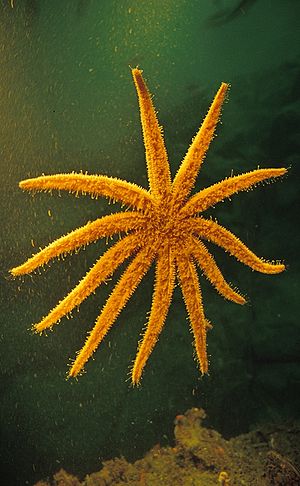Eleven-armed sea star facts for kids
Quick facts for kids Coscinasterias calamaria |
|
|---|---|
 |
|
| Scientific classification | |
| Kingdom: | |
| Phylum: | |
| Subphylum: |
Eleutherozoa
|
| Class: | |
| Order: |
Forcipulatida
|
| Family: |
Asteriidae
|
| Genus: |
Coscinasterias
|
| Species: |
C. calamaria
|
| Binomial name | |
| Coscinasterias calamaria (Gray, 1840)
|
|
| Synonyms | |
|
|
The eleven-armed sea star (Coscinasterias calamaria) is a type of starfish that lives in the ocean. It belongs to the Asteriidae family. People used to think it only lived around southern Australia and New Zealand. But now, we know it also lives near the Cape Peninsula in South Africa. You can find these sea stars in shallow waters, even at low tide. They often hide under rocks or move over seaweed in tide pools.
Contents
What Does the Eleven-Armed Sea Star Look Like?
The Coscinasterias calamaria is the biggest starfish found in southern Australia and New Zealand. Even though it's called the "eleven-armed sea star," it can actually have anywhere from seven to fourteen arms. Eleven arms are just the most common number.
You might notice that some of its arms are different lengths. This happens because sea stars can lose an arm, and then a new one grows back in its place! This starfish also has tiny, pincer-like structures called pedicellariae. These are on both its top and bottom surfaces, making it look a bit prickly. A fully grown eleven-armed sea star can be up to 30 centimeters (about 12 inches) wide.
Where Do Eleven-Armed Sea Stars Live?
This sea star is originally from the coasts of Australia and New Zealand. Its home range stretches from Rottnest Island in Western Australia, all the way around the southern coast to New South Wales. It can be found as far north as Point Dangar in Queensland. This includes places like Tasmania and Lord Howe Island.
How Do Eleven-Armed Sea Stars Live?
What Do Eleven-Armed Sea Stars Eat?
The eleven-armed sea star mostly eats blue mussels (Mytilus edulis). It also feeds on other small creatures that live on the ocean floor, called benthic invertebrates. Usually, it doesn't eat the blacklip abalone (Haliotis rubra). However, if there aren't enough mussels around, groups of these sea stars will start to eat abalone.
Even though lab tests show they prefer abalone, abalone have ways to escape attacks. One way might be by releasing a special chemical that keeps the sea stars away. Sea stars have special smell sensors on the tips of their arms. These help them find food very accurately by smell. Once they find food, they push their stomach out over it. Then, they release special chemicals called enzymes to turn the food into liquid before pulling their stomach back inside. If food is hard to find, these sea stars can go many weeks without eating.
How Do Eleven-Armed Sea Stars Reproduce?
The eleven-armed sea star mostly reproduces by splitting itself in two. This is called fissiparity. It tears itself apart right through its central body disc. Amazingly, a whole new sea star can grow from just one arm, but only if that arm includes a piece of the central disc.
They can also reproduce in the usual way, by sexual reproduction. It's hard to know which way of reproducing is more important for these sea stars. However, scientists have found that sea stars living very close together have similar genes. But sea stars found just 50 meters (about 164 feet) apart can have very different genes. This is especially true for those living in deeper waters.

